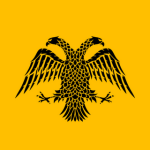Home > Blossary: Byzantine Empire
The Byzantine Empire was the predominantly Greek-speaking continuation of the Roman Empire during Late Antiquity and the Middle Ages. Its capital city was Constantinople (modern-day Istanbul), originally known as Byzantium. Initially the eastern half of the Roman Empire (often called the Eastern Roman Empire in this context), it survived the 5th century fragmentation and fall of the Western Roman Empire and continued to exist for an additional thousand years until it fell to the Ottoman Turks in 1453. During most of its existence, the empire was the most powerful economic, cultural, and military force in Europe. Both "Byzantine Empire" and "Eastern Roman Empire" are historiographical terms applied in later centuries; its citizens continued to refer to their empire as the Roman Empire , and Romania .
Like
Created by: KSGRAM
Number of Blossarys: 9
Slovak (SK)
Compare Language
Phocas (born at 547 – died at 5 October 610) was Byzantine Emperor from 602 to 610. He usurped the throne from the Emperor Maurice, and was himself overthrown by Heraclius after losing a civil war.
Domain: History; Category: European history
The Byzantine Iconoclasm (Eikonomachía) refers to two periods in the history of the Byzantine Empire when the use of religious images or icons was opposed by religious and imperial authorities within ...
Domain: History; Category: European history
Leo III the Isaurian also known as the Syrian (born at 685 – died at 18 June 741) was Byzantine Emperor from 717 until his death in 741. He put an end to a period of instability, successfully ...
Domain: History; Category: European history
In 330, Constantine moved the seat of the Empire to Constantinople, which he founded as a second Rome on the site of Byzantium, a city strategically located on the trade routes between Europe and ...
Domain: Geography; Category: Human geography
As a symbol and expression of the universal prestige of the Patriarchate of Constantinople, Justinian built the Church of the Holy Wisdom of God, Hagia Sophia, which was completed in the short period ...
Domain: Religion; Category: General religion
Constantine XI Dragaš Palaiologos, Latinized as Palaeologus ( born at February 1404 – died at 29 May 1453) was the last reigning Byzantine Emperor, reigning as a member of the Palaiologos dynasty ...
Domain: History; Category: European history
Alexios's son John II Komnenos succeeded him in 1118 and ruled until 1143. John was a pious and dedicated Emperor who was determined to undo the damage to the empire suffered at the Battle of ...
Domain: History; Category: European history
My other Blossarys
A list noting some of the most worthy scientists ...
Category: Science
By: KSGRAM
A list of the amazing wonders that man made in ...
Category: History
By: KSGRAM
A blossary to make you familiar with some of the ...
Category: Geography
By: KSGRAM
Greek mythology is the body of myths and ...
Category: History
By: KSGRAM


 English (EN)
English (EN)





